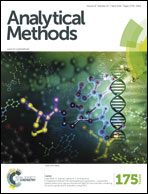Algorithmic modeling of spectroscopic data to quantify binary mixtures of vinegars of different botanical origins†
Abstract
Multiple binary mixtures of different kinds of vinegars have been analyzed through UV-Vis absorption. Two types of mathematical models (multiple linear regression (MLR) and artificial neural networks (ANNs)) have been employed to identify and quantify the components of such blends. Six different vinegars were used to prepare these mixtures, each one with a particular botanical origin: white wine, red wine, apple cider, apple, molasses, and rice. The best results have been obtained with ANN based models, offering mean estimation error value averages of 1% (v/v) and mean correlation coefficients (R2) over 0.99. This model is adequate to perform the estimation and achieve an accurate and reliable tool. Nevertheless, although the MLR models provide worse results (0.88 in terms of R2 and 5% v/v error), they can be used depending on the application and required accuracy.


 Please wait while we load your content...
Please wait while we load your content...